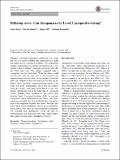Files in this item
Differing views - can chimpanzees do level 2 perspective-taking?
Item metadata
| dc.contributor.author | Karg, Katja | |
| dc.contributor.author | Schmelz, Martin | |
| dc.contributor.author | Call, Josep | |
| dc.contributor.author | Tomasello, Michael | |
| dc.date.accessioned | 2016-02-11T16:40:10Z | |
| dc.date.available | 2016-02-11T16:40:10Z | |
| dc.date.issued | 2016-05 | |
| dc.identifier | 240524205 | |
| dc.identifier | 884bf173-487a-4949-be25-bb3877fd0291 | |
| dc.identifier | 84957591319 | |
| dc.identifier | 000373743900011 | |
| dc.identifier.citation | Karg , K , Schmelz , M , Call , J & Tomasello , M 2016 , ' Differing views - can chimpanzees do level 2 perspective-taking? ' , Animal Cognition , vol. 19 , no. 3 , pp. 555-564 . https://doi.org/10.1007/s10071-016-0956-7 | en |
| dc.identifier.issn | 1435-9448 | |
| dc.identifier.other | ORCID: /0000-0002-8597-8336/work/37477957 | |
| dc.identifier.uri | https://hdl.handle.net/10023/8206 | |
| dc.description | We gratefully acknowledge financial support by the German National Academic Foundation. | en |
| dc.description.abstract | Although chimpanzees understand what others may see, it is unclear if they understand how others see things (Level 2 perspective-taking). We investigated whether chimpanzees can predict the behavior of a conspecific which is holding a mistaken perspective that differs from their own. The subject competed with a conspecific over two food sticks. While the subject could see that both were the same size, to the competitor one appeared bigger than the other. In a previously established game, the competitor chose one stick in private first and the subject chose thereafter, without knowing which of the sticks was gone. Chimpanzees and 6-year-old children chose the ‘riskier’ stick (that looked bigger to the competitor) significantly less in the game than in a nonsocial control. Children chose randomly in the control, thus showing Level 2 perspective-taking skills; in contrast, chimpanzees had a preference for the ‘riskier’ stick here, rendering it possible that they attributed their own preference to the competitor to predict her choice. We thus run a follow-up in which chimpanzees did not have a preference in the control. Now they also chose randomly in the game. We conclude that chimpanzees solved the task by attributing their own preference to the other, while children truly understood the other’s mistaken perspective. | |
| dc.format.extent | 664815 | |
| dc.language.iso | eng | |
| dc.relation.ispartof | Animal Cognition | en |
| dc.subject | Perspective taking | en |
| dc.subject | Appearance-reality | en |
| dc.subject | Deception | en |
| dc.subject | False belief | en |
| dc.subject | Chimpanzee | en |
| dc.subject | BF Psychology | en |
| dc.subject | RC0321 Neuroscience. Biological psychiatry. Neuropsychiatry | en |
| dc.subject | QL Zoology | en |
| dc.subject | NDAS | en |
| dc.subject.lcc | BF | en |
| dc.subject.lcc | RC0321 | en |
| dc.subject.lcc | QL | en |
| dc.title | Differing views - can chimpanzees do level 2 perspective-taking? | en |
| dc.type | Journal article | en |
| dc.contributor.institution | University of St Andrews. School of Psychology and Neuroscience | en |
| dc.contributor.institution | University of St Andrews. Centre for Social Learning & Cognitive Evolution | en |
| dc.identifier.doi | https://doi.org/10.1007/s10071-016-0956-7 | |
| dc.description.status | Peer reviewed | en |
This item appears in the following Collection(s)
Items in the St Andrews Research Repository are protected by copyright, with all rights reserved, unless otherwise indicated.

